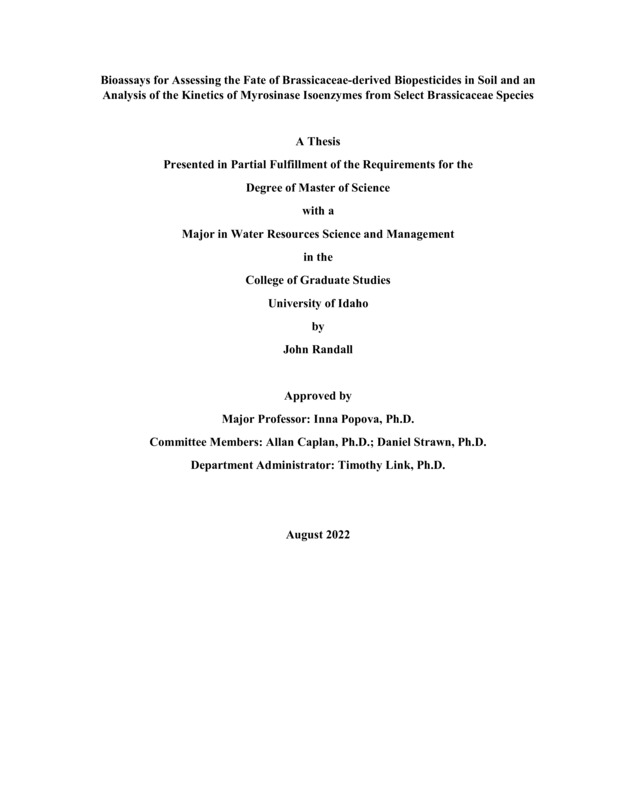Bioassays for Assessing the Fate of Brassicaceae-derived Biopesticides in Soil and an Analysis of the Kinetics of Myrosinase Isoenzymes from Select Brassicaceae Species
Randall, John Robert. (2022-08). Bioassays for Assessing the Fate of Brassicaceae-derived Biopesticides in Soil and an Analysis of the Kinetics of Myrosinase Isoenzymes from Select Brassicaceae Species. Theses and Dissertations Collection, University of Idaho Library Digital Collections. https://www.lib.uidaho.edu/digital/etd/items/randall_idaho_0089n_12438.html
- Title:
- Bioassays for Assessing the Fate of Brassicaceae-derived Biopesticides in Soil and an Analysis of the Kinetics of Myrosinase Isoenzymes from Select Brassicaceae Species
- Author:
- Randall, John Robert
- Date:
- 2022-08
- Keywords:
- bioassay biopesticides brassicaceae myrosinase wireworm
- Program:
- Soil & Water Systems
- Subject Category:
- Soil sciences; Agriculture; Biochemistry
- Abstract:
-
Abstract
Seed meal of plants from the family Brassicaceae contains glucosinolates which are hydrolyzed by the endogenous enzyme myrosinase to toxic isothiocyanates which have been shown to be effective for treating a wide array of pest species. Current analytical methods for studying the fate of these pesticides in soil require expensive equipment which may not be affordable for many researchers. The inability of farmers, land managers, and researchers to analyze the fate of these pesticides hinders data collection and may limit the efficacy of current application methods due to the time delay between pesticide application and determination of fate. The overarching goal of this study were to understand the fate of allyl isothiocyanate (AITC) from sinigrin (2-propenyl glucosinolate) in agricultural soil. Specific objectives were 1) to explore the use of bioindicators such as wireworms, Limonius infuscatus for pesticide fate studies which could be assessed in-situ and ex-situ; 2) to study the kinetics of myrosinase isoenzymes from Brassica juncea, Sinapis alba, and Limnanthes alba using sinigrin, glucolimnanthin (m-methoxybenzyl glucosinolate), and sinalbin (4-hydroxylbenzyl glucosinolate) as substrates to assess which myrosinase source will result in the highest production of biopesticide in the soil. Two wireworm bioassays were evaluated. The first assay was used to assess the effects of soil depth and incubation period on the fate of the biopesticides. Pre weighed wireworms were used as bioindicators and isolated at specific depths in soil columns which were treated with B. juncea seed meal. The columns were incubated for 4 or 8 days, then the wireworms were assessed for mass change and mortality. The soil was analyzed for AITC, glucosinolates, sulfate, pH, and electrical conductivity. The second assay assessed the effects of tarping on the efficacy of B. juncea seed meal against wireworms. A single pre weighed wireworm was placed midway in a soil column which was treated with B. juncea seed meal. Columns were covered with a polypropylene sheet to simulate field tarping and were incubated for 2 days, then the wireworms were removed, and their mass, mortality, and vertical location were recorded. The wireworms were transferred to fresh soil with wheat seeds as a food source and monitored weekly for mass change and mortality. Soil was analyzed for AITC, electrical conductivity, and pH. In the first assay, neither depth nor incubation period significantly affected wireworm mortality and mass change; however, meal application, depth, and incubation period did significantly affect soil EC, pH, and sulfate concentration. This may be due to glucosinolate hydrolysis as well as acids and ionic compounds in the meal. In the second assay, wireworms in treated columns which were tarped showed significantly higher mortality than wireworms in treated columns which were uncovered which did not show significantly different mortality rates than those in the control columns, suggesting AITC volatilization may significantly reduce, or completely negate the effects of biopesticide. Treatment also had a significant effect on pH, and electrical conductivity. The myrosinase isoenzyme from S. alba showed the highest maximum activity of the three isoenzymes with sinigrin and glucolimnanthin as substrates. The maximum activity of S. alba with sinigrin and glucolimnanthin was significantly higher than the maximum activity of B. juncea; however, B. juncea myrosinase had a significantly greater affinity for both sinigrin and glucolimnanthin. S. alba had the greatest Vmax with sinigrin as a substrate and had similar maximum activities for both glucolimnanthin and sinalbin. This may be due to the similarity in structure of these aromatic glucosinolates. B. juncea myrosinase exhibited Michaelis Menten kinetics for sinigrin and glucolimnanthin but showed signs of substrate inhibition for sinalbin. This suggests that there may be an allosteric binding site on the B. juncea myrosinase which selectively binds sinalbin. The myrosinase extract from L. alba showed negligible activity and may have degraded prior to extraction.
- Description:
- masters, M.S., Soil & Water Systems -- University of Idaho - College of Graduate Studies, 2022-08
- Major Professor:
- Popova, Inna
- Committee:
- Strawn, Daniel; Caplan, Allan; Link, Timothy
- Defense Date:
- 2022-08
- Identifier:
- Randall_idaho_0089N_12438
- Type:
- Text
- Format Original:
- Format:
- application/pdf
- Rights:
- In Copyright - Educational Use Permitted. For more information, please contact University of Idaho Library Special Collections and Archives Department at libspec@uidaho.edu.
- Standardized Rights:
- http://rightsstatements.org/vocab/InC-EDU/1.0/

